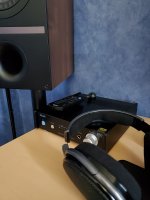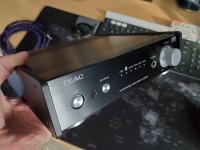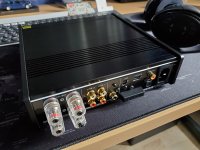Man of Honour

I should firstly add that I am not a graph based person, I can only share what my ears tell me from listening to sound in words, not curves and charts!
I'd been recently looking at the updated X model of the seemingly popular AI-301DA and got frustrated at the lack of decent reviews. A few people on forums had them and posted brief comments saying it was doing them fine, but not really a comparison based view based on similar amp/DAC hybrids.
So once my NAD D 7050 was away for repair (hopefully... I have another thread open here about my experience with the NAD) I figured I'd give the TEAC a try whilst I await to see what happens with my D 7050. Previously I have owned the D 3020 v1 as well and all have been powering a pair of KEF Q300 bookshelf speakers and Sennheiiser HD650.

Immediately out the box the TEAC has heft and quality about its presence. The all metal construction feels premium, and the old school layout of the LEDs and controls is nice. I also liked the weighted motorised metal volume knob.
Connecting it all up to my PC was no problem. Windows 10 worked out the box without a driver, but installing the TEAC driver set the default sound settings to 32/192 if I remember right, whereas the Windows driver sets it to 24/48. I don't know what else the TEAC driver adds other than ASIO support?
Anyway the sound remained unchanged with either and ultimately was the reason I decided to return it for a refund.

All these years I have had NAD amps from the C310 Bee all the way to the C325 Bee in the pre-digital days and then jumping to the D 3020 v1. I owned a few other brands between those years like Rotel, Cambridge Audio, Technics and Pioneer, but always went back to NAD as the sound just felt the most honest, highs and lows alike were natural, smooth... warm. I could fall asleep listening to music through them and wouldn't even think about maybe something being missing whereas with the other amps (and now this TEAC) I can't help but ask myself why the highs sound like there's a filter muffling their detail in the middle before being output to the headphones or speakers?
I even played all manner of content from lossless to compressed from 4K trailers to local and streaming music. It just didn't sit well with my ears. Vocals were being presented centrally so movies sounded like everyone was talking in the middle of my head rather than a nice wide soundstage although instruments in acoustic etc were separated nicely.
The bass was deep but not as detailed as what the D 7050 was capable of outputting to both HD650 and Q300s. I can't help but think the 310DA-X is aimed more to the living room or casual computer user who wants better than standard PC audio on their system as opposed to someone who just appreciate honest details being reproduced in whatever they are listening to.
Maybe the TEAC is not matched nicely to my headphones and speakers whereas a NAD amp loves this combo? I only have these so I cannot compare to other outputs.
It's a shame really as I really liked its dinky desktop size and how it looks but it looks like I am stuck with NAD amps forever. So much so that when I contacted my local dealer, they gave me £100 off the price of a new D 3045 as they understood the issues I was having with my D 7050. I couldn't say no to that offer so have a 3045 coming tomorrow. More power than the 7050, less noise, more efficient and more features like the two-way Bluetooth which I will use to play audio to the JayBird X3s when I don't want the faff of a chunky cable getting in the way etc.
Observations:
- When plugging the headphones in, there was no resister clicking when it disables the speaker output. Every amp I have owned has always had a resister circuit flip when you connect and disconnect headphones. There is a resister flip when turning the amp on and off though.
- When turning the volume knob you can hear the stepping as faint noise as the level increases or decreases.
- The power switch on the front panel is a digital micro-switch not a physical clicky switch which it looks like on photos.
- It's very hard to see what the volume dial level is at because the indicator dot is too small to see without getting close to the amp or directly in front of it. No hope in the dark though as it's not LED illuminated.
- Windows volume control affects the output level to the 301DA-X. This I found annoying because I don;t like faffing with Windows volume to find the sweet spot for speakers then headphones I don't know what volume level on Windows correlates closest to 0.0dB on a typical scale (if we were talking about line level output for example). The volume difference between speaker and headphone output is big too. With Windows set to 90, the speakers are too loud for comfort when the TEAC volume dial is at about turned 20% but when connecting the headphones at these levels the volume through the headphones is too slow so need to turn the knob closer to 50% to get the same level as the speakers were. With the NADs the volume remained consistent between headphone and speakers so I didn't need to think twice about this.
Also the NADs bypassed any Windows volume control setting so Windows could be set to 90, 30 45.... whatever, the DACs just took the raw signal untouched and did its thing.
- There was not UK power cord in the box, only EU. Luckily it's a kettle lead so had one spare.
- The sticker on the underside of the AI-301DA-X states it is a AI-301DA as does the printed model designation on the front of the panel. The packaging box however states it is in fact a AI-301DA-X. If you throw away the box then you have nothing to prove it is an X instead of the older non X....
Final words:
I am annoyed with NAD because they chose to re-use the horrible rubbery plastic side panels on the 3045 instead of at least a matte textured plastic panel. And then there is the glossy curved top and front panels which attract dust and fingerprints like other. Why could this not have been aluminium or at leats all matte at this price?
It is what it is however and I'll have to live with regular cleaning and keeping on top of those rubbery side panels getting sticky after a year or two with rubbing alcohol.
Hopefully something up there is useful to someone as I know a few have been looking at feedback on this TEAC amp just as I was. I don't know what the non X sounded like but TEAC's site says the X was tuned in Europe and has improved output quality. If this is what the X sounds like then I'd have hated the non X.
I don't like rating things out of 10 etc bu if I had to then...
Sound: 6/10 - It's good and loud, but not "honest" or natural to my ears.
Build quality: 10/10 - It feels so good in the hands and everything has a tactile feel or lubed smoothness (ladies....).

